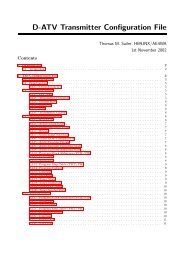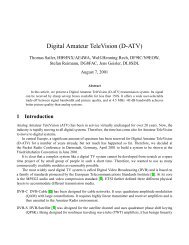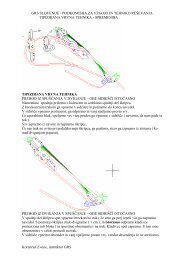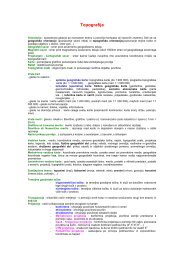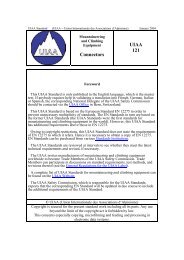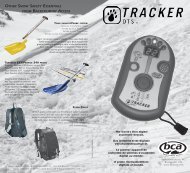A Newsletter for Friends of the CAIC
A Newsletter for Friends of the CAIC
A Newsletter for Friends of the CAIC
- No tags were found...
You also want an ePaper? Increase the reach of your titles
YUMPU automatically turns print PDFs into web optimized ePapers that Google loves.
Monkey Businesscontinued from page threeSTORM 1Our big wea<strong>the</strong>r/avalanche cycle consisted <strong>of</strong>three distinct storms. The first arrived on December29th, at <strong>the</strong> end <strong>of</strong> a long stretch <strong>of</strong> snow-weakeningcold and mostly dry wea<strong>the</strong>r. These conditions helpweak layers to <strong>for</strong>m near <strong>the</strong> surface <strong>of</strong> <strong>the</strong> snowpack.The result is a rotten foundation <strong>for</strong> future snows toland upon.The first in this series <strong>of</strong> southwesterly stormsarrived fast and furious and set <strong>the</strong> pace <strong>for</strong> <strong>the</strong> firsthalf <strong>of</strong> January. It began with a bully layer <strong>of</strong> slipperygraupel (a precipitation particle that looks like a smallStyr<strong>of</strong>oam ball) that was soon topped with heavy wetsnow. This was accompanied by sustained wind averagesin <strong>the</strong> 30’s and gusts reaching a whopping 90+mph. As <strong>the</strong> storm unfolded, we anticipated that 1.5to 2 inches <strong>of</strong> water would kick <strong>of</strong>f a natural avalanchecycle, and it did. By late that Wednesday afternoon,we had received 2 inches <strong>of</strong> snow water equivalentin less than 24-hours. That led to four naturaland seven mitigated avalanches hitting <strong>the</strong> road over RedMountain Pass. The Molas/Coal Bank side <strong>of</strong> Highway 550 sawfour natural and three mitigated avalanches reach <strong>the</strong> highwaycenterline. Spot road closures <strong>for</strong> avalanche mitigation andcleanup finally evolved to a full closure <strong>of</strong> <strong>the</strong> passes. Mo<strong>the</strong>rNature’s wrath <strong>of</strong> high winds, high precipitation rates andapproaching darkness declared, “You are not <strong>the</strong> boss <strong>of</strong> me!”The road remained closed until 4 pm <strong>the</strong> next day. The stormdumped <strong>the</strong> most snow on Molas Pass. We measured 21 inches<strong>of</strong> snowfall and 2.85 inches <strong>of</strong> water in just over 24-hours.STORM 2With only a few days to catch up, a second strong Pacific stormarrived late on January 3rd. Once again <strong>the</strong> wind averaged 30mph with gusts reaching into <strong>the</strong> mid 70’s. These were perfectconditions <strong>for</strong> transporting large amounts <strong>of</strong> snow into our avalanchestart zones. Temperatures were warm and thus <strong>the</strong> snowwas heavy. As <strong>the</strong> snowfall reached 2 inches an hour, <strong>the</strong>re wasano<strong>the</strong>r natural avalanche cycle and Red Mountain Pass closedagain. It didn’t open <strong>for</strong> ano<strong>the</strong>r 43-hours. Natural and mitigatedavalanches put as much as 15 feet <strong>of</strong> snow on <strong>the</strong> road. This time<strong>the</strong> Coal Bank study plot won <strong>the</strong> “most snowfall” prize, with 35inches <strong>of</strong> snow and over 3 inches <strong>of</strong> snow water equivalent. Withlarge amounts <strong>of</strong> new snow and water, high winds and a weakunderlying snowpack, we had all <strong>the</strong> ingredients <strong>for</strong> an avalanchecycle. Once we got back on <strong>the</strong> road we saw <strong>the</strong> remains <strong>of</strong>natural avalanches on all aspects. However, much to our dismay<strong>the</strong> snow in many <strong>of</strong> our larger paths remained intact. We hadhoped that more <strong>of</strong> <strong>the</strong> avalanche paths would “clean out.” Thecurrent wea<strong>the</strong>r pattern was <strong>for</strong>ecast to continue, and as <strong>the</strong> loadon our weak snowpack continued to climb, we could feel <strong>the</strong>pressure <strong>of</strong> <strong>the</strong> situation build.BIG STORMThe wea<strong>the</strong>r pattern did continue. Two days later, a superstormmoved into <strong>the</strong> San Juan Mountains from <strong>the</strong> southwest.The last storm <strong>of</strong> our record breaking cycle began Friday January7th, and battering <strong>the</strong> region through <strong>the</strong> following Wednesday.This last storm came crashing down upon us, snowing an inch anhour or more <strong>for</strong> six days. The initial wave <strong>of</strong> snow was low indensity, but as <strong>the</strong> storm continued <strong>the</strong> snow became wet andPowder cloud from East Riverside path reaches Highway 550. (Photo: Gary King)heavy. This is a classic “upside-down” snow storm and a textbookscenario <strong>for</strong> an avalanche cycle. Strong southwest winds, gustinginto <strong>the</strong> 60’s, compounded <strong>the</strong> situation. In <strong>the</strong> wee hours <strong>of</strong>January 8th, our most reliable per<strong>for</strong>mer, <strong>the</strong> Blue Point avalanchepath, put three feet <strong>of</strong> snow across 40 feet <strong>of</strong> <strong>the</strong> centerline. Soonafterward, an avalanche in <strong>the</strong> East Riverside path released.Dragging <strong>the</strong> snow from adjacent paths in its wake, <strong>the</strong> avalancherumbled down into <strong>the</strong> Ironton Gorge. These slides covered <strong>the</strong>road with four feet <strong>of</strong> snow. Later in <strong>the</strong> storm, <strong>the</strong>se paths wouldavalanche again and actually pack <strong>the</strong> only avalanche shed covering<strong>the</strong> highway with three feet <strong>of</strong> snow.On <strong>the</strong> Coal Bank side, an avalanche in <strong>the</strong> Henry Brown pathcovered <strong>the</strong> road with some <strong>of</strong> <strong>the</strong> o<strong>the</strong>r paths quickly joining <strong>the</strong>fray. With darkness nipping at our heals, wind and snowfallquickly moved snow back into <strong>the</strong> start zones as we completed<strong>the</strong> avalanche mitigation work. Dangerous travel conditions andsanity finally won out, and by 11:00 pm <strong>the</strong> north and south sections<strong>of</strong> Highway 550 out <strong>of</strong> Silverton were closed. As <strong>the</strong> mo<strong>the</strong>r<strong>of</strong> all storms continued, <strong>the</strong> monstrous avalanche paths flowingdown from peaks high above Red Mountain Pass and County Rd110 defied all “control”. The roads remained closed <strong>for</strong> sevenlong days.Our next day <strong>of</strong> work began early on <strong>the</strong> morning <strong>of</strong> January9th. While conducting avalanche hazard mitigation we used both<strong>the</strong> Avalauncher (an explosive delivery system designed <strong>for</strong> avalanchework), and brought out our WWII era artillery, a 105 mmHowitzer. We concentrated our ef<strong>for</strong>ts on <strong>the</strong> passes south <strong>of</strong>Silverton, hoping to open one escape route from <strong>the</strong> town. But inspite <strong>of</strong> all <strong>the</strong> fire-power, frustration became <strong>the</strong> <strong>the</strong>me <strong>of</strong> <strong>the</strong>day with only a few avalanches releasing. While wea<strong>the</strong>r andsnowpack conditions certainly validated <strong>the</strong> previous night’s decisionto close <strong>the</strong> roads, we still expected big “results” to validateour <strong>for</strong>ecast. Un<strong>for</strong>tunately, <strong>the</strong> most action was caused by afrightened big-horn sheep that kicked <strong>of</strong>f a series <strong>of</strong> small slides in<strong>the</strong> East Lime Creek path while we were shooting West Lime.We eventually worked our way back to Silverton, tails tuckedbetween our legs. We had managed to get <strong>the</strong> Coal Bank side <strong>of</strong>Highway 550 open. I was happy because this meant my husbandcould high-tail it home from Durango and help shovel snow.There was enough daylight <strong>for</strong> one attempt to open RedMountain Pass. Disappointed with our progress, we geared up <strong>for</strong>one set <strong>of</strong> Howitzer shots on <strong>the</strong> Red Mountain side.4The Beacon, Winter 2006 ! Volume 10, Number 2






